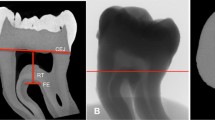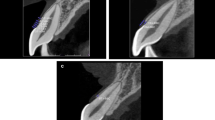Abstract
Objectives
To evaluate the relationship between the tomographic sagittal root position (SRP) of maxillary anterior teeth and periodontal phenotype (PP).
Material and methods
Seventy volunteers (420 teeth) were evaluated. Clinical and photographic exams included the evaluation of gingival phenotype (GP) by transparency of the periodontal probe, keratinized tissue width (KTW), gingival architecture, tooth shape, and papilla height (PH). Soft tissue tomographic scan (ST-CBCT) measurements included the SRP classification, GP, gingival thickness in the tissue zone (GT-TZ) and in the bone zone (GT-BZ), buccal bone thickness (BBT), and the distances from the gingival margin and from cementoenamel junction to the buccal bone crest (GM-BBC and CEJ-BBC). Kruskal–Wallis test and a linear regression analysis model were used.
Results
The frequency of SRP over the 420 teeth was 65.2% (class I), 9.3% (class II), 0.7% (class III), and 24.8% (class IV). Linear regression analysis showed that SRP is related to PP (p < 0.05). Significantly different measurements of PP parameters were found in SRP classes. The higher and lower GT and BBT were found in classes II and I, respectively. Class IV presented the highest KTW, PH, CEJ-BBC, and GM-BBC. Central incisors (CI) classes I and II were most frequently square-shaped, while 89% of CI Class IV were triangular-shaped.
Conclusion
The SRP of maxillary anterior teeth is related to periodontal phenotype.
Clinical relevance
Clinical and ST-CBCT individual analysis of PP and SRP may be helpful for an esthetic and functional treatment plan based on soft and hard tissue thickness and tooth positioning.





Similar content being viewed by others
References
Jepsen S, Caton JG, Albandar JM, Bissada NF, Bouchard P, Cortellini P, Demirel K, de Sanctis M, Ercoli C, Fan J, Geurs NC, Hughes FJ, Jin L, Kantarci A, Lalla E, Madianos PN, Matthews D, McGuire MK, Mills MP, Preshaw PM, Reynolds MA, Sculean A, Susin C, West NX, Yamazaki K (2018) Periodontal manifestations of systemic diseases and development of acquired conditions: consensus report of workgroup 3 of the 2017 World Workshop on the Classification of Periodontal and Peri-Implant Diseases and Conditions. J Periodontol 89(Suppl 1):S237–S248. https://doi.org/10.1002/JPER.17-0733
Zweers J, Thomas RZ, Slot DE, Weisgold AS, Van der Weijden FG (2014) Characteristics of periodontal biotype, its dimensions, associations and prevalence: a systematic review. J Clin Periodontol 41(10):958–971. https://doi.org/10.1111/jcpe.12275
Arora R, Narula SC, Sharma RK, Tewari S (2013) Supracrestal gingival tissue: assessing relation with periodontal biotypes in a healthy periodontium. Int J Periodontics Restorative Dent 33(6):763–71. https://doi.org/10.11607/prd.1501
Kan JY, Morimoto T, Rungcharassaeng K, Roe P, Smith DH (2010) Gingival biotype assessment in the esthetic zone: visual versus direct measurement. Int J Periodontics Restorative Dent 30(3):237–243. https://doi.org/10.11607/prd.00.0918
Kan JY, Rungcharassaeng K, Umezu K, Kois J (2003) Dimensions of peri-implant mucosa: an evaluation of maxillary anterior single implants in humans. J Periodontol 74(4):557–562. https://doi.org/10.1902/jop.2003.74.4.557
La Rocca AP, Alemany AS, Levi P Jr, Juan MV, Molina JN, Weisgold AS (2012) Anterior maxillary and mandibular biotype: relationship between gingival thickness and width with respect to underlying bone thickness. Implant Dent 21(6):507–515. https://doi.org/10.1097/ID.0b013e318271d487
Müller HP, Eger T (2002) Masticatory mucosa and periodontal phenotype: a review. Int J Periodontics Restorative Dent 22(2):172–183. https://doi.org/10.11607/prd.00.0468
Alpiste-Illueca F (2004) Dimensions of the dentogingival unit in maxillary anterior teeth: a new exploration technique (parallel profile radiograph). Int J Periodontics Restorative Dent 24(4):386–396. https://doi.org/10.11607/prd.00.0587
Januario AL, Barriviera M, Duarte WR (2008) Soft tissue cone-beam tomography: a novel method for the measurement of gingival tissue and the dimensions of the dentogingival unit. J Esthet Restorative Dent 20(6):366–374. https://doi.org/10.1111/j.1708-8240.2008.00210
Tsigarida A, Toscano J, de Brito BB, Geminiani A, Barmak AB, Caton J, Papaspyridakos P, Chochlidakis K (2020) Buccal bone thickness of maxillary anterior teeth: a systematic review and meta-analysis. J Clin Periodontol 47(11):1326–1343. https://doi.org/10.1111/jcpe.13347
Kao RT, Fagan MC, Conte GJ (2008) Thick vs.thin gingival biotypes: a key determinant in treatment planning for dental implants. J Calif Dent Assoc 36(3):193–198
Eger T, Müller HP, Heinecke A (1997) Ultrasonic determination of gingival thickness. Subject variation and influence of tooth type and clinical features. J Clin Periodontol 23(9):839–845. https://doi.org/10.1111/j.1600-051x.1996.tb00621.x
Müller HP, Könönen E (2005) Variance components of gingival thickness. J Periodontal Res 40(3):239–244. https://doi.org/10.1111/j.1600-0765.2005.00798.x
Vandana KL, Savitha B (2005) Thickness of gingiva in association with age, gender and dental arch location. J Clin Periodontol 32(7):828–830. https://doi.org/10.1111/j.1600-051X.2005.00757.x
Gluckman H, Pontes CC, Du Toit J (2018) Radial plane tooth position and bone wall dimensions in the anterior maxilla: a CBCT classification for immediate implant placement. J Prosthet Dent 120(1):50–56. https://doi.org/10.1016/j.prosdent.2017.09.005
Kheur MG, Kantharia NR, Kheur SM, Acharya A, Le B, Sethi T (2015) Three- dimensional evaluation of alveolar bone and soft tissue dimensions of maxillary central incisors for immediate implant placement: a cone-beam computed tomography assisted analysis. Implant Dent 24(4):407–415. https://doi.org/10.1097/ID.0000000000000259
Lau SL, Chow J, Li W, Chow LK (2011) Classification of maxillary central incisors- implications for immediate implant in the esthetic zone. J Oral Maxillofac Surg 69(1):142–153. https://doi.org/10.1016/j.joms.2010.07.074
Wang HM, Shen JW, Yu MF, Chen XY, Jiang QH, He FM (2014) Analysis of facial bone wall dimensions and sagittal root position in the maxillary esthetic zone: a retrospective study using cone beam computed tomography. Int J Oral Maxillofac Implants 29(5):1123–1129. https://doi.org/10.11607/jomi.3348
Kan JY, Roe P, Rungcharassaeng K, Patel RD, Waki T, Lozada JL, Zimmerman G (2011) Classification of sagittal root position in relation to the anterior maxillary osseous housing for immediate implant placement: a cone beam computed tomography study. Int J Oral Maxillofac Implants 26(4):873–876
von Elm E, Altman DG, Egger M, Pocock SJ, Gøtzsche PC, Vandenbroucke JP (2007) The Strengthening the Reporting of Observational Studies in Epidemiology (STROBE) statement: guidelines for reporting observational studies. Lancet 370(9596):1453–1457. https://doi.org/10.1016/S0140-6736(07)61602-X
World Medical Association (2013) World Medical Association Declaration of Helsinki: ethical principles for medical research involving human subjects. JAMA 310(20):2191–2194. https://doi.org/10.1001/jama.2013.281053
Olsson M, Lindhe J, Marinello CP (1993) On the relationship between crown form and clinical features of the gingiva in adolescents. J Clin Periodontol 20(8):570–577. https://doi.org/10.1111/j.1600-051x.1993.tb00773.x
Gobbato L, Tsukiyama T, Levi PA Jr, Griffin TJ, Weisgold AS (2012) Analysis of the shapes of maxillary central incisors in a Caucasian population. Int J Periodontics Restorative Dent 32(1):69–78. https://doi.org/10.11607/prd.00.1037
Landis JR, Koch GG (1977) The measurement of observer agreement for categorical data. Biometrics 33:159–174
Gwet KL (2008) Intrarater reliability. In: Hoboken, NJ (ed) Wiley Encyclopedia of Clinical Trials, John Wiley & Sons, Gaisthersburg, pp 1-14
Dancey CP, Reidy J (2006) Statistics without mathematics to psychology: using SPSS for Windows. Artmed, Porto Alegre
Frost NA, Mealey BL, Jones AA, Huynh-Ba G (2015) Periodontal biotype: gingival thickness as it relates to probe visibility and buccal plate thickness. J Periodontol 86(10):1141–1149. https://doi.org/10.1902/jop.2015.140394
Amid R, Mirakhori M, Safi Y, Kadkhodazadeh M, Namdari M (2017) Assessment of gingival biotype and facial hard/soft tissue dimensions in the maxillary anterior teeth region using cone beam computed tomography. Arch Oral Biol 79(1):1–6. https://doi.org/10.1016/j.archoralbio.2017.02.021
Borges GJ, Ruiz LFN, de Alencar AHG, Porto OCL, Estrela C (2015) Cone-beam computed tomography as a diagnostic method for determination of gingival thickness and distance between gingival margin and bone crest. SciWorld J 142108:1–10. https://doi.org/10.1155/2015/142108
Maria N, Lazaros T, Christos A, Georgiou M, Ioannis V, Antonios K (2016) Classification of periodontal biotypes with the use of CBCT. A cross-sectional study Clin Oral Invest 20(8):2061–2071. https://doi.org/10.1007/s00784-015-1694-y
Kim DM, Bassir SH, Nguyen TT (2020) Effect of gingival phenotype on the maintenance of periodontal health: an American Academy of Periodontology best evidence review. J Periodontol 91(3):311–338. https://doi.org/10.1002/JPER.19-0337
Lin GH, Curtis DA, Kapila Y, Velasquez D, Kan JY, Tahir P, Avilla-Ortiz G, Kao RT (2020) The signifcance of surgically modifying soft tissue phenotype around fixed dental prosthesis: an American Academy of Periodontology best evidence review. J Periodontol 91(3):339–351. https://doi.org/10.1002/JPER.19-0310
Maynard JG Jr, Wilson RDK (1980) Diagnosis and management of mucogingival problems in children. Dent Clin North Am 24(4):683–703
Misawa M, Lindhe J, Araujo MG (2016) The alveolar process following single-tooth extraction: a study of maxillary incisor and premolar sites in man. Clin Oral Implants Res 27(7):884–889. https://doi.org/10.1111/clr.12710
Januario AL, Duarte WR, Barriviera M, Mesti JC, Araujo MG, Lindhe J (2011) Dimension of the facial bone wall in the anterior maxilla: a cone-beam computed tomography study. Clin Oral Implants Res 22(10):1168–1171. https://doi.org/10.1111/j.1600-0501.2010.02086.x
Chappuis V, Araujo MG (2000) Buser D (2017) Clinical relevance of dimensional bone and soft tissue alterations post-extraction in esthetic sites. Periodontol 73(1):73–83. https://doi.org/10.1111/prd.12167
Müller HP, Eger T (1997) Gingival phenotypes in young male adults. J Clin Periodontol 24(1):65–71. https://doi.org/10.1111/j.1600-051x.1997.tb01186.x
Kois JC (1996) The restorative-periodontal interface: biological parameters. Periodontology 2000 11(1):29–38. https://doi.org/10.1111/j.1600-0757.1996.tb00180.x.
Barboza EP, Monte Alto RF, Ferreira VF, Carvalho WR (2008) Supracrestal gingival tissue measurements in healthy human periodontium. Int J Periodontics Restorative Dent 28(1):55–61. https://doi.org/10.11607/prd.00.0779
Smukler H, Chaibi M (1997) Periodontal and dental considerations in clinical crown extension: a rational basis for treatment. Int J Periodontics Restorative Dent 17(5):464–477
Stellini E, Comuzzi L, Mazzocco F, Parente N, Gobbato L (2013) Relationship between different tooth shapes and patient’s periodontal phenotype. J Periodontal Res 48(5):657–662. https://doi.org/10.1111/jre.12057
Sterrett JD, Oliver T, Robinson F, Fortson W, Knaak B, Russell CM (1999) Width/length ratios of normal clinical crowns of the maxillary anterior dentition in man. J Clin Periodontol 26(3):153–157. https://doi.org/10.1034/j.1600-051x.1999.260304.x
Kolte R, Kolte A, Mahajan A (2014) Assessment of gingival thickness with regards to age, gender and arch location. Journal of Indian Society of Periodontology 18(4):478. https://doi.org/10.4103/0972-124X.138699
Egreja AM, Kahn S, Barceleiro M, Bittencourt S (2012) Relationship between the width of the zone of keratinized tissue and thickness of gingival tissue in the anterior maxilla. Int J Periodontics Restorative Dent 32(5):573–579
Ainamo J, Talari A (1976) The increase with age of the width of attached gingiva. J Periodont Res 11(4):182–188
Jaju PP, Jaju SP (2015) Cone-beam computed tomography: time to move from ALARA to ALADA. Imaging Sci Dent 45(4):263–265. https://doi.org/10.5624/isd.2015.45.4.263
Funding
The work was supported by the “Coordenação de Aperfeiçoamento de Pessoal de Nível Superior—Brazil (CAPES)”—Finance Code 001- Scholarship (CM).
Author information
Authors and Affiliations
Corresponding author
Ethics declarations
Conflict of interest
The authors declare no competing interests.
Ethical approval
This study was approved by the Ethics Committee of the Federal Fluminense School of Medicine (CEP/HUAP/UFF 506.300), in accordance with the 1964 Helsinki declaration and its later amendments.
Informed consent
Informed consent was obtained from all individual participants included in the study.
Additional information
Publisher's Note
Springer Nature remains neutral with regard to jurisdictional claims in published maps and institutional affiliations.
Supplementary Information
Below is the link to the electronic supplementary material.
784_2021_4105_MOESM1_ESM.tif
Supplementary file1 (TIF 3359 KB) Flow diagram on the selection of study participants and measurement sites according to the inclusion and exclusion criteria.
784_2021_4105_MOESM2_ESM.docx
Supplementary file2 (DOCX 17 KB) Frequency distribution of gingival thickness (thick or thin) and association with SRP classification
Rights and permissions
About this article
Cite this article
Rodrigues, D.M., Petersen, R.L., Montez, C. et al. Relationship between anterior maxillary tooth sagittal root position and periodontal phenotype: a clinical and tomographic study. Clin Oral Invest 26, 1309–1321 (2022). https://doi.org/10.1007/s00784-021-04105-1
Received:
Accepted:
Published:
Issue Date:
DOI: https://doi.org/10.1007/s00784-021-04105-1




